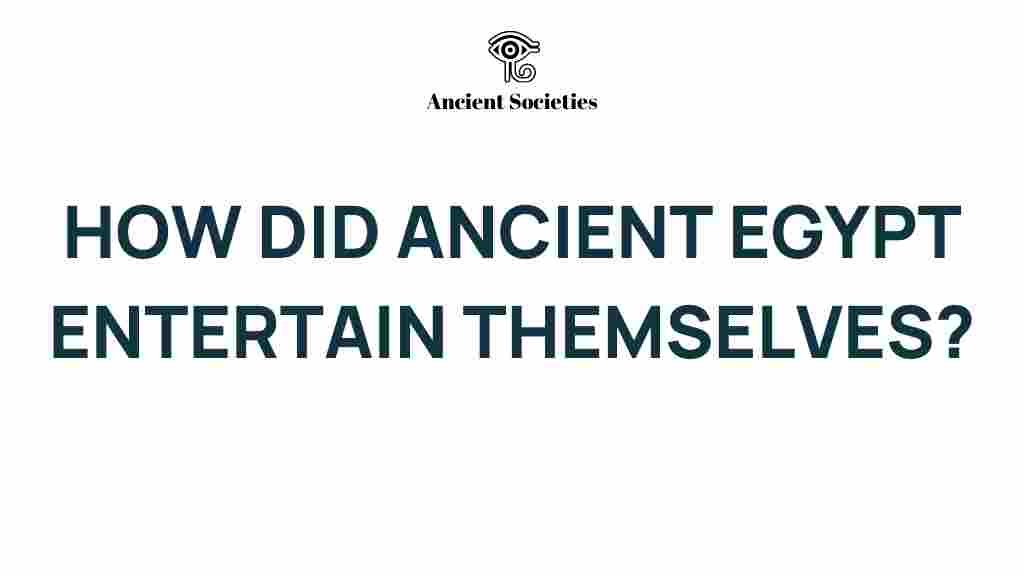Unveiling the Secrets of Ancient Egypt’s Unique Entertainment
Ancient Egypt, a civilization known for its remarkable achievements in art, architecture, and social structure, also had a rich tapestry of entertainment that played a significant role in its culture and daily life. From music and dance to elaborate festivals and leisure activities, the entertainment of Ancient Egypt was a reflection of its history and social dynamics. In this article, we will explore the various forms of entertainment in Ancient Egypt, how they shaped social life, and their lasting impact on culture.
The Cultural Significance of Entertainment in Ancient Egypt
Entertainment in Ancient Egypt was not merely a means of passing the time; it was deeply intertwined with the culture and religion of the society. Various forms of entertainment served to:
- Enhance social cohesion
- Celebrate religious rituals and festivals
- Express artistic talent and creativity
- Provide leisure and relaxation for both the elite and common people
Understanding the entertainment practices of this ancient civilization helps us appreciate their values and way of life. Entertainment was a vital part of social gatherings, religious ceremonies, and cultural expression, showcasing the vibrancy of Ancient Egyptian society.
Leisure Activities in Ancient Egypt
Leisure activities in Ancient Egypt varied widely across different social classes. While the elite enjoyed more luxurious forms of entertainment, common people engaged in simpler pastimes. Here are some popular leisure activities:
- Board Games: Games such as Senet were played by people of all ages, often seen as a test of strategy and luck.
- Sports: Activities like archery, hunting, and wrestling were prominent, especially among the nobility.
- Gardening: Many Egyptians took pride in cultivating gardens, which provided both beauty and food.
- Fishing and Boating: The Nile River offered opportunities for fishing, and boating was a common recreational activity.
Music and Dance in Ancient Egypt
Music and dance were integral components of entertainment in Ancient Egypt, often performed during religious ceremonies and celebrations. Musicians and dancers held a respected position in society, and their performances were enjoyed by all. Key elements include:
- Instruments: Common instruments included harps, flutes, and percussion. Each instrument played a unique role in enhancing the experience of entertainment.
- Dance Styles: Dancers often performed to tell stories or celebrate significant events, employing movements that were both graceful and expressive.
Music and dance not only entertained but also helped in the spiritual connection to the gods, showcasing the deep-rooted belief in the divine.
Festivals and Their Role in Social Life
Festivals were a highlight of the Ancient Egyptian calendar, serving both religious and social purposes. These events were characterized by:
- Processions: Grand parades featuring statues of gods and goddesses, accompanied by music and dance.
- Feasting: Abundant food and drink were staples of festivals, allowing communities to come together and celebrate.
- Competitions: Athletic competitions and games were held, fostering community spirit and camaraderie.
Some of the most notable festivals included:
- The Opet Festival: Celebrated the annual flooding of the Nile and honored the god Amun.
- The Wepet-Renpet Festival: Marked the beginning of the New Year, filled with joy and revelry.
These festivals showcased the vibrant social life of Ancient Egyptians, highlighting their connection to the divine and to one another.
Art as Entertainment
Art was a significant aspect of entertainment in Ancient Egypt, often serving both aesthetic and functional purposes. The art forms of Ancient Egypt included:
- Painting: Murals and tomb paintings depicted scenes of daily life, mythology, and the afterlife, often conveying deeper meanings.
- Sculpture: Statues of gods, pharaohs, and animals were prominent, often used in religious contexts but also serving decorative purposes.
- Literature: Storytelling through poetry and prose was a form of entertainment, with tales often centered around gods, heroes, and the afterlife.
Art not only entertained but also educated, providing insights into the beliefs and values of Ancient Egyptian society.
Social Life and Hierarchical Influences
Entertainment in Ancient Egypt was influenced by social hierarchy. The elite enjoyed lavish forms of entertainment, while commoners engaged in simpler activities. This segregation was evident in:
- Access to Performances: While nobles could host grand banquets and hire skilled musicians, commoners often watched performances in public spaces.
- Quality of Leisure Activities: The wealthy had access to luxury items and exclusive events, while the lower classes enjoyed more accessible leisure activities.
This socio-economic divide shaped the entertainment landscape, reflecting the broader cultural and historical context of Ancient Egypt.
Challenges in Understanding Ancient Egyptian Entertainment
Despite extensive archaeological discoveries, understanding the full scope of entertainment in Ancient Egypt presents challenges:
- Limited Documentation: Much of what we know comes from inscriptions and art, leaving gaps in understanding how entertainment was experienced.
- Interpretation of Art: The meanings behind artistic representations can be subjective, leading to varied interpretations among scholars.
To gain a deeper understanding, further research and archaeological findings are essential for uncovering the nuances of Ancient Egyptian entertainment.
Conclusion
Ancient Egypt’s unique entertainment was a vital aspect of its culture, history, and social life. From music and dance to festivals and art, these forms of leisure not only provided enjoyment but also played a crucial role in expressing the beliefs and values of the society. By studying the entertainment practices of Ancient Egypt, we can appreciate the complexity of their social dynamics and their enduring legacy in the history of human civilization.
For more information on the cultural practices of Ancient Egypt, check out this informative resource. If you’re interested in exploring more about Ancient Egyptian art, visit this external link for additional insights.
This article is in the category Culture and created by AncientSocieties Team
